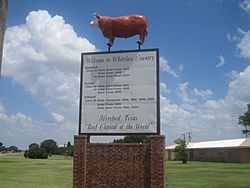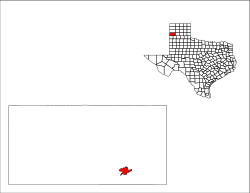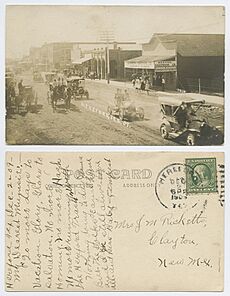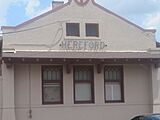Hereford, Texas facts for kids
Quick facts for kids
Hereford
|
|
|---|---|

Hereford welcome sign on U.S. Highway 385
|
|
| Nickname(s):
Beef Capital of the World;
The Town Without a Toothache |
|

Location of Hereford, Texas
|
|
 |
|
| Country | United States of America |
| State | Texas |
| County | Deaf Smith |
| Area | |
| • Total | 6.30 sq mi (16.32 km2) |
| • Land | 6.30 sq mi (16.32 km2) |
| • Water | 0.00 sq mi (0.00 km2) |
| Elevation | 3,819 ft (1,164 m) |
| Population
(2020)
|
|
| • Total | 14,972 |
| • Density | 2,376.51/sq mi (917.40/km2) |
| Time zone | UTC-6 (Central (CST)) |
| • Summer (DST) | UTC-5 (CDT) |
| ZIP code |
79045
|
| Area code(s) | 806 |
| FIPS code | 48-33320 |
| GNIS feature ID | 2410747 |
Hereford (/ˈhɜːrfərd/ HUR-fərd) is a city in and county seat of Deaf Smith County, Texas, United States. It is 48 miles southwest of Amarillo. Its population was 14,972 at the 2020 census. It is the only incorporated locality named "Hereford" in the United States.
The area is known for its semiarid climate, with heavy farming and ranching throughout the area sustained by irrigation from the Ogallala Aquifer and the saltier Santa Rosa Aquifer beneath it.
Hereford's local water supply contains an unusually high level of naturally occurring fluoride. Because fluoride is used to protect against tooth decay, Hereford earned the title "The Town Without a Toothache".
It is also known as the "Beef Capital of the World" because of the large number of cattle feedlots in the area. The city is named for the Hereford breed. The local economy is affected significantly by growth in the dairy and ethanol industries.
Hereford is also home to the headquarters of the Deaf Smith Electric Cooperative, which serves Deaf Smith, Castro, Parmer, and Oldham Counties.
Contents
History
Hereford was founded as "Blue Water" in 1899 after the Pecos and Northern Texas Railway connected Amarillo to Farwell. After a town already named Blue Water was discovered, residents renamed the town "Hereford" in honor of the cattle of the local ranchers and the city, Hereford, in the United Kingdom.
During World War II, a prisoner-of-war camp existed there for Italian prisoners of war. It was dismantled in 1947.
In 1975, popular high school teacher Wayne Woodward was fired for his efforts to establish a local branch of the American Civil Liberties Union. Mr. Woodward won a subsequent legal suit, that gained national attention, against the Hereford Independent School District. The events were documented in the 2022 book You Will Never Be One of Us by Timothy P. Bowman.
A rich Western heritage includes the Las Escarbadas ranch house of the XIT Ranch, once located southwest of Hereford. The restored historic structure can now be seen at the National Ranching Heritage Center at Texas Tech University in Lubbock. The Deaf Smith County Historical Museum at 400 Sampson Street in Hereford offers indoor and outdoor exhibits on the settlement of West Texas.
Hereford was once known as the "Windmill City" due to its many windmills supplying fresh water from the Ogallala Aquifer.
Geography
Hereford is located in southeastern Deaf Smith County and on the Llano Estacado. According to the United States Census Bureau, the city has a total area of 5.9 square miles (15.4 km2), all land.
U.S. Highway 60 passes through the city as 1st Street, leading northeast 48 miles (77 km) to Amarillo and southwest 57 miles (92 km) to Clovis, New Mexico. U.S. Highway 385 (25 Mile Avenue) runs north–south through the city, leading north 30 miles (48 km) to Interstate 40 at Vega and south 20 miles (32 km) to Dimmitt.
Climate
Hereford's climate is classified as a steppe climate (BSk) using the 2006 map of Köppen climate classification, meaning it is semiarid. Hereford was named as the "coolest" city in Texas with an average summer temperature of 73 °F or 22.8 °C.
| Climate data for Hereford, Texas (1991–2020 normals, extremes 1905–1912, 1936–present) | |||||||||||||
|---|---|---|---|---|---|---|---|---|---|---|---|---|---|
| Month | Jan | Feb | Mar | Apr | May | Jun | Jul | Aug | Sep | Oct | Nov | Dec | Year |
| Record high °F (°C) | 84 (29) |
85 (29) |
98 (37) |
99 (37) |
103 (39) |
111 (44) |
109 (43) |
107 (42) |
102 (39) |
97 (36) |
87 (31) |
80 (27) |
111 (44) |
| Mean maximum °F (°C) | 71.0 (21.7) |
76.2 (24.6) |
84.3 (29.1) |
89.5 (31.9) |
96.0 (35.6) |
102.1 (38.9) |
101.4 (38.6) |
99.2 (37.3) |
95.8 (35.4) |
89.3 (31.8) |
79.7 (26.5) |
71.4 (21.9) |
104.1 (40.1) |
| Mean daily maximum °F (°C) | 51.1 (10.6) |
55.5 (13.1) |
64.3 (17.9) |
72.4 (22.4) |
81.1 (27.3) |
90.2 (32.3) |
92.4 (33.6) |
90.7 (32.6) |
83.5 (28.6) |
72.6 (22.6) |
60.3 (15.7) |
51.1 (10.6) |
72.1 (22.3) |
| Daily mean °F (°C) | 36.8 (2.7) |
40.4 (4.7) |
48.3 (9.1) |
56.1 (13.4) |
65.7 (18.7) |
75.4 (24.1) |
78.6 (25.9) |
77.1 (25.1) |
69.7 (20.9) |
57.9 (14.4) |
45.8 (7.7) |
37.4 (3.0) |
57.4 (14.1) |
| Mean daily minimum °F (°C) | 22.5 (−5.3) |
25.3 (−3.7) |
32.4 (0.2) |
39.7 (4.3) |
50.3 (10.2) |
60.6 (15.9) |
64.8 (18.2) |
63.5 (17.5) |
55.8 (13.2) |
43.3 (6.3) |
31.3 (−0.4) |
23.8 (−4.6) |
42.8 (6.0) |
| Mean minimum °F (°C) | 9.3 (−12.6) |
11.1 (−11.6) |
18.4 (−7.6) |
26.5 (−3.1) |
36.9 (2.7) |
51.4 (10.8) |
59.0 (15.0) |
56.9 (13.8) |
43.7 (6.5) |
28.2 (−2.1) |
16.6 (−8.6) |
8.9 (−12.8) |
4.2 (−15.4) |
| Record low °F (°C) | −15 (−26) |
−17 (−27) |
1 (−17) |
14 (−10) |
16 (−9) |
40 (4) |
51 (11) |
44 (7) |
31 (−1) |
15 (−9) |
0 (−18) |
−12 (−24) |
−17 (−27) |
| Average precipitation inches (mm) | 0.64 (16) |
0.45 (11) |
1.22 (31) |
1.09 (28) |
2.09 (53) |
3.34 (85) |
2.34 (59) |
3.04 (77) |
1.86 (47) |
1.85 (47) |
0.69 (18) |
0.72 (18) |
19.33 (491) |
| Average snowfall inches (cm) | 3.2 (8.1) |
1.7 (4.3) |
1.9 (4.8) |
0.7 (1.8) |
0.1 (0.25) |
0.0 (0.0) |
0.0 (0.0) |
0.0 (0.0) |
0.0 (0.0) |
0.6 (1.5) |
2.5 (6.4) |
3.6 (9.1) |
14.3 (36) |
| Average precipitation days (≥ 0.01 in) | 2.8 | 3.2 | 4.3 | 4.8 | 6.4 | 7.6 | 6.9 | 8.3 | 5.7 | 5.2 | 3.7 | 3.6 | 62.5 |
| Average snowy days (≥ 0.1 in) | 1.7 | 1.2 | 1.0 | 0.3 | 0.1 | 0.0 | 0.0 | 0.0 | 0.0 | 0.2 | 0.9 | 1.8 | 7.2 |
| Source: NOAA | |||||||||||||
Demographics
| Historical population | |||
|---|---|---|---|
| Census | Pop. | %± | |
| 1900 | 532 | — | |
| 1910 | 1,750 | 228.9% | |
| 1920 | 1,696 | −3.1% | |
| 1930 | 2,458 | 44.9% | |
| 1940 | 2,584 | 5.1% | |
| 1950 | 5,207 | 101.5% | |
| 1960 | 6,752 | 29.7% | |
| 1970 | 13,414 | 98.7% | |
| 1980 | 15,853 | 18.2% | |
| 1990 | 14,745 | −7.0% | |
| 2000 | 14,597 | −1.0% | |
| 2010 | 15,370 | 5.3% | |
| 2020 | 14,972 | −2.6% | |
| U.S. Decennial Census | |||
2020 census
| Race | Number | Percentage |
|---|---|---|
| White (NH) | 2,757 | 18.41% |
| Black or African American (NH) | 98 | 0.65% |
| Native American or Alaska Native (NH) | 39 | 0.26% |
| Asian (NH) | 32 | 0.21% |
| Some Other Race (NH) | 39 | 0.26% |
| Mixed/Multi-Racial (NH) | 129 | 0.86% |
| Hispanic or Latino | 11,878 | 79.33% |
| Total | 14,972 |
As of the 2020 United States census, there were 14,972 people, 4,776 households, and 3,593 families residing in the city.
2010 census
As of the 2010 United States Census, 15,370 people resided in the city. The racial makeup of the city was 71.7% Hispanic or Latino, 26.3% White, 0.9% Black, 0.2% Native American, 0.3% Asian, 0.1% from some other race, and 0.5% from two or more races.
Education
The first public school was opened in 1900. Today, Hereford's seven public schools serve around 4,000 students and are directed by the Hereford Independent School District.
Notable people
- Parker Bridwell, pitcher for MLB's New York Yankees, was born in Hereford.
- Ron Ely, actor, best remembered for his role as Tarzan on an NBC television series in the 1960s, was born in Hereford in 1938
- Lon L. Fuller (1902–1978), American legal philosopher known for his advocacy of a secular form of natural law theory, was born in Hereford
- Rip Hawk, professional wrestler, lived in Hereford, after retiring from wrestling.
- Edgar Mitchell (1930–2016), who on Apollo 14 in 1971 became the sixth astronaut to walk on the Moon, was born in Hereford.
- Skeeter Skelton, lawman and firearms writer
Gallery
-
Downtown Hereford, with the grain elevator to the rear
-
St. Anthony's Roman Catholic Church in Hereford is located off U.S. Highway 385.
See also
 In Spanish: Hereford (Texas) para niños
In Spanish: Hereford (Texas) para niños










